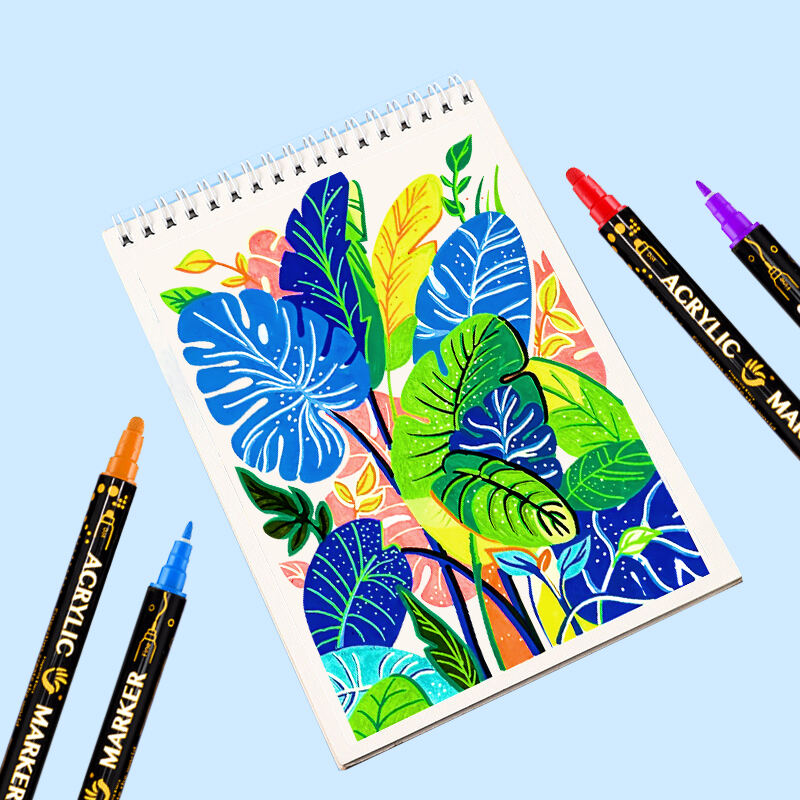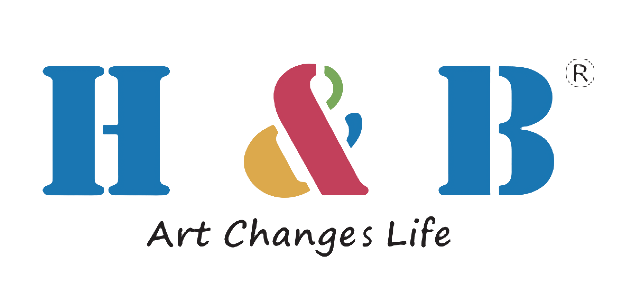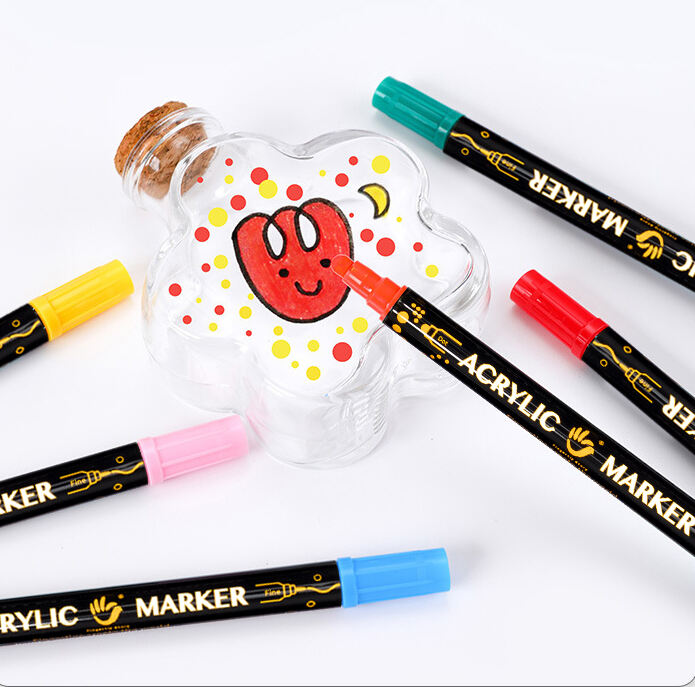The Psychology of Marker Use in Creativity Enhancement
How Marker Interaction Activates Neurological Pathways
Studies show there's something pretty interesting happening in our brains when we mess around with markers, especially when it comes to sparking creativity. When people actually touch and move markers across paper, certain parts of the brain light up related to creative thinking and solving problems. The simple act of holding and manipulating these tools seems to strengthen connections in the brain through all those senses working together, which makes using real markers feel much different than just tapping on a screen. Take pressure for instance how hard someone presses down affects the line quality, and changing grip styles while drawing influences how thoughts flow during brainstorming sessions. That's why many artists and designers still reach for good old fashioned markers whenever they need to generate fresh ideas.
Sensory Feedback Loops: Tactile Markers vs Digital Tools
Tactile markers give us instant sensory feedback that really matters when our brains are working through ideas. Digital tools just don't have that same feel as holding a marker between fingers and watching color appear on paper. Traditional markers create this physical connection that makes people feel more in control while they explore their creativity. Research indicates folks who actually use physical markers tend to stay motivated longer on creative projects and produce better work overall. Sure, digital devices might block those important sensory signals from reaching the brain, but markers provide something almost everyone finds intuitive. That hands-on experience seems to kickstart thinking processes and keeps creativity flowing naturally instead of getting stuck in digital limbo.
Types of Markers for Different Creative Processes
Permanent Markers for Precision Brainstorming
Permanent markers work really well for brainstorming because they leave bold marks that stick around forever, making them great for writing down solid ideas that won't fade away. The bright colors stand out clearly on almost any surface, which helps teams work together better when things get hectic. When people need to remember what was said quickly during meetings, these markers make all the difference. Many folks who've used them report better memory retention too, so creative thinking tends to flow more smoothly throughout the session as everyone can see what's been written without confusion.
Washable Markers for Experimental Thinking
Washable markers work really well when trying to get people thinking outside the box. Because they wash off easily, folks feel free to try out wild ideas without worrying about making lasting errors. This makes them great for brainstorming sessions where nobody gets stuck on one idea forever. Teachers have noticed something interesting too. Classrooms that use these kinds of markers tend to see better results from students working on creative projects. Kids just seem to bounce ideas around more freely since there's no pressure to get everything right the first time. The whole room feels more open and relaxed about creativity because nobody has to deal with messy cleanup after every attempt.
Specialized Art Markers for Professional Visualization
Art markers designed for specialized work really shine when tackling complex visual projects. They're available in all sorts of tip sizes from ultra-fine points to broad chisel tips, giving artists just the right amount of control needed for those intricate illustrations and artwork details. What makes these markers stand out is how they deliver crisp lines and vibrant colors that make presentations look sharp and professional. According to some market research, good quality art markers do more than just look nice on paper they actually speed up workflow too. That's why so many designers keep a full set handy at their workstation, whether they're creating storyboards for animation or preparing marketing materials for clients.

Marker-Based Techniques for Ideation Development
Freeform Doodling as Cognitive Warm-Up
Doodling freely on paper works wonders for getting those brain gears turning and sparking creative ideas. When people let their minds wander through random drawings instead of rigid planning, they often find new connections between seemingly unrelated concepts. Studies have shown time and again that this kind of unstructured drawing actually helps generate fresh perspectives needed for truly innovative thinking. Grabbing some colorful markers makes all the difference too. The act of putting ink to paper gives thoughts physical form, which somehow makes brainstorming sessions feel less stressful and more productive overall.
Color Coding Systems for Idea Organization
Using colored markers to code information turns out to be really helpful when trying to sort out thoughts during those brain storming meetings. When people assign different colors to various types of ideas or priorities, it actually keeps everyone on track instead of getting lost in random chatter. Some research into color theory indicates blue might calm folks down while red seems to get creative juices flowing faster, which makes sense for brainstorming contexts. We've seen teams work better together when they adopt this method too. One marketing group I know started marking client concerns in orange and solutions in green, and suddenly everyone could see what was happening without someone constantly explaining everything again.
Mind Mapping with Dual-Tip Marker Variations
Dual tip markers really take mind mapping to another level visually speaking. When someone draws with both fine and broad tips, they can create layers that help separate main ideas from supporting details. This makes it easier to spot connections between concepts later on. Research from educational psychology actually shows that people remember information better when they use colorful visuals during note taking. The cool thing about dual tip markers is how they let map makers switch between writing text and drawing shapes without constantly changing pens. Notes end up being both thorough and interesting to look at, which keeps the brain engaged longer than plain old bullet points ever could.
Workplace Applications: Fostering Group Creativity
Collaborative Whiteboard Marker Strategies
Whiteboard markers designed for collaboration really change how groups work together during meetings, turning them into creative brainstorming opportunities. There's this technique called brain writing where everyone adds their thoughts at once on the board instead of waiting for someone else to speak first. People get involved more when they can see what others are thinking right away. Companies have noticed something interesting happens too. When teams actually draw out their ideas together on whiteboards, they tend to stick together better as a group and come up with some pretty good innovations. That's why many workplaces now consider these marker sessions essential for keeping creativity alive among staff members.
Marker-Anchored Design Thinking Workshops
Workshops focused on design thinking with lots of markers going around really get people involved in solving problems through actual doing rather than just talking about them. The whole point is getting groups together to brainstorm ideas and give each other feedback, which tends to lead to better creative solutions down the road. When facilitators bring out those colorful markers during sessions, folks actually seem more engaged and happy with whatever comes out of the group work. Studies have found that when people draw and write things down during these marker-filled workshops, they end up feeling satisfied with how their team's ideas turned out. Beyond making everyone more creative, this method helps teams work better together and actually put their plans into action instead of letting them gather dust on someone's desk.
Analog vs Digital Marking in Hybrid Teams
Getting to grips with how analog and digital tools affect each other matters a lot for teams working together in mixed environments who want their creative juices flowing. Some studies point out that switching back and forth between old school methods and modern tech actually boosts creativity because people get different ways to express themselves. When teams bring in things like handwritten notes or physical whiteboards during virtual meetings, it brings back that hands on feeling everyone misses, which helps close those communication chasms we often see online. Teams have found this works wonders for brainstorming sessions. Companies are starting to realize these simple tricks not only spark better ideas but also make remote collaboration feel more connected and productive across all sorts of work situations.
Educational Value: Markers in Developmental Creativity
Fine Motor Skill Development Through Marker Grip
Markers really help kids develop those important fine motor skills because they need to hold them just right. Research from occupational therapists shows that using markers actually helps improve hand-eye coordination something we all need when doing simple things like writing letters or putting on socks. For little ones starting school, this matters a lot since markers not only make writing easier but also let them express themselves creatively through drawings and art projects. When children keep practicing with markers regularly, their hand muscles get stronger over time. This means they'll eventually have better control over their fingers and hands, making all sorts of tasks much easier as they grow.
Ephemeral Marking: Reducing Perfectionism in Youth
Ephemeral marking focuses on the idea that things don't have to last forever, and this actually helps younger artists get comfortable with making mistakes while cutting down on their need for everything to be perfect. Studies in psychology back this up too, showing how when kids know their work doesn't have to stay around forever, they're more willing to take chances creatively without worrying so much about getting it right once and for all. Schools that incorporate ephemeral marking into their programs tend to see students coming up with more original ideas. These students start thinking differently about problems and learning by trial and error rather than just trying to follow rules. The whole point is to build a mindset where creativity flourishes because there's no pressure to produce perfect results every single time.
Cross-Curricular Creativity Boosters
Markers are pretty amazing when it comes to bringing different school subjects together in creative ways. Teachers who look at curriculum planning find that when kids get to use markers for projects in several classes, they actually pay more attention and learn better. People who believe in letting students express themselves creatively really push for including markers in classrooms because they help bridge gaps between subjects. For instance, drawing geometric shapes while learning math or sketching scientific diagrams makes those abstract concepts feel real. What's great about markers is they make kids curious and want to work together on projects. Students end up talking through problems, sharing ideas, and sometimes even discovering connections between topics that nobody expected. This kind of hands-on approach just makes learning stick better over time.
FAQ Section
What is the psychological impact of using markers for creativity?
Using markers for creativity stimulates areas of the brain associated with creativity and problem-solving, enhancing neurological pathways through sensory engagement.
How do tactile markers differ from digital tools in the creative process?
Tactile markers provide immediate sensory feedback, offering a tangible sense of control that enhances creative exploration, while digital tools often lack this tactile element.
What advantages do permanent markers offer during brainstorming sessions?
Permanent markers are ideal for capturing definitive ideas due to their bold, long-lasting marks, enhancing visibility and recall rates during team collaborations.
Why are washable markers beneficial for experimental thinking?
Washable markers encourage creative risks without the fear of permanent mistakes, promoting iterative thinking processes and greater learning outcomes in creative tasks.
In what ways do specialized art markers influence professional visualization?
Specialized art markers offer precision and high-quality finishes, impacting the visual clarity and professionalism of illustrations and presentations.
How can freeform doodling aid cognitive warm-up?
Freeform doodling allows relaxation, encouraging exploration without structured constraints and stimulating divergent thinking, crucial for innovative idea generation.
What are the benefits of using color coding systems with markers?
Color coding systems help organize ideas logically, aiding mood and creativity levels, enhancing communication and contributions during brainstorming sessions.
How do dual-tip markers improve mind mapping?
Dual-tip markers enrich mind mapping by facilitating layered approaches, aiding in distinguishing thoughts and associations, thereby supporting better retention and understanding.
Why are collaborative whiteboard markers important in workplace creativity?
Collaborative whiteboard markers transform group meetings into dynamic brainstorming sessions, enhancing team cohesion and leading to innovative workplace outcomes.
What role do markers play in design thinking workshops?
Markers promote hands-on problem-solving and innovation, enhancing engagement and satisfaction with group solutions in design thinking workshops.
How do analog vs digital tools impact hybrid team creativity?
Incorporating analog marking in virtual settings bridges communication gaps and strengthens team connections, maximizing creative potential in hybrid workplaces.
Table of Contents
- The Psychology of Marker Use in Creativity Enhancement
- Types of Markers for Different Creative Processes
- Marker-Based Techniques for Ideation Development
- Workplace Applications: Fostering Group Creativity
- Educational Value: Markers in Developmental Creativity
-
FAQ Section
- What is the psychological impact of using markers for creativity?
- How do tactile markers differ from digital tools in the creative process?
- What advantages do permanent markers offer during brainstorming sessions?
- Why are washable markers beneficial for experimental thinking?
- In what ways do specialized art markers influence professional visualization?
- How can freeform doodling aid cognitive warm-up?
- What are the benefits of using color coding systems with markers?
- How do dual-tip markers improve mind mapping?
- Why are collaborative whiteboard markers important in workplace creativity?
- What role do markers play in design thinking workshops?
- How do analog vs digital tools impact hybrid team creativity?


